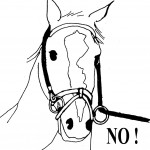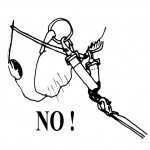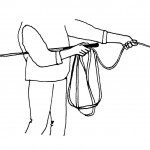Working on the Lunge Line – Part 9
|
|
Arbeit an der Longe – Teil 9
|
The lunge line:
- Since we established earlier that a lunge line is not needed (at least with our kind of training) to prevent the horse from running away, we must ask ourselves, what its true purpose is!
- Since the lunge line replaces the reins when working like this on the circle, it has the function of establishing the connection from the horse’s mouth to the human hand – i.e. it is the means to make the dialogue possible, which is supposedly happening between human and horse during this kind of schooling. Dialogue – not battle!! This dialogue is much harder to achieve than in riding via the reins, as the lunge line is so much longer and has so much more dead weight. This is why we must approach the learning of this “conversation” in a different manner than in riding.
- I will show you how we do that, but first a few words about the equipment.
- The lunge line is held in that hand which does not hold the whip! In order to avoid that either lunger or vaulters step onto, or wrap themselves in, the lunge line, I advise you, just like for all other training games (the games from in “From Leading to Liberty” and films “Playing with Horses”) to separate the “rope hand” (here the lunging hand) and the “whip hand” consistently in their respective roles.
- This makes a lot of sense when you consider that your horse, who is a very sharp observer, already deduces a lot of your intentions from your movements – also from how you hold the equipment.
- The hand loop of the lunge should never be slipped over your wrist. If a situation becomes dangerous, you must be able to let go, so you are never in danger of getting dragged! Just like when sailing, as with all occupations with lines and ropes, those must always be orderly, so that you can let them slip out with control and retake them just as orderly. Long loops, into which your feet could get caught up, can be a danger to your life!
|
|
Die Longe:
- Da wir schon festgestellt haben, daß (zumindest mit unserer Art von Training) die Longe nicht dazu da ist, das Pferd am Wegrennen zu hindern, müssen wir uns nun fragen, was ihr wirklicher Zweck dann ist!
- Da die Longe bei der Arbeit auf dem Zirkel in etwa die Zügel ersetzt, soll sie die Verbindung von Pferdemaul zu der Menschenhand herstellen – das heißt, sie ist das Mittel für den Dialog, der zwischen Mensch und Pferd bei dieser Art Arbeit stattfinden soll. Dialog – nicht Kampf!! Dieser Dialog gestaltet sich sehr viel schwieriger als beim Reiten via Zügel, da die Longe so viel länger ist und auch schon so viel mehr Eigengewicht hat. Daher müssen wir das Erlernen dieser “Unterhaltung” anders angehen als beim Reiten.
- Ich werde zeigen, wie wir das machen, aber zuerst noch ein paar Worte über die Ausrüstung selbst.
- Die Longe wird in der Hand gehalten, in der sich die Peitsche nicht befindet! Damit nicht Pferd, Longierer oder Voltigierer auf die Longe treten oder sich in derselben verwickeln, rate ich, genau wie bei allem anderen Trainingsspielen (all den Spielen in “From Leading to Liberty” und Filme “Playing with Horses” auch mit deutscher Tonspur!) dringend dazu, die “Seilhand” (also hier die Longenhand) und die “Peitschenhand” konsequent in ihren Rollen zu trennen.
- Dies ist sehr sinnvoll im Hinblick darauf, daß Ihr Pferd, welches ja ein sehr scharfer Beobachter ist, so an Ihren Bewegungen und wie Sie die Ausrüstung halten, schon viel Ihrer Absichten erkennen kann.
- Das Schlaufenende der Longe sollte niemals auf das Handgelenk gestreift werden. Wenn es gefährlich wird, muß man loslassen können, um nicht geschleppt zu werden! Wie beim Segeln, wie bei allen Arbeiten mit Seilen, müssen die Leinen immer ordentlich sein, so daß man sie ruhig gleitend auslassen und ebenso ordentlich wieder aufnehmen kann. Lange Schlaufen, in die man sich mit den Füßen verheddern kann, sind unter Umständen lebensgefährlich!
|
 There are different ways to hold the lunge – choose what guarantees the softest contact!
Separate the “lunge-hand” from the “whip-hand” for clear communication with the horse |
- For vaulting competitions the lunger holds the lunge line as he would hold the reins while riding. But whoever does not have to adhere to competition rules should hold the lunge in such a way, which is most efficient to keep the softest and best steady contact with the horse. With increasing arthritis this may even vary from the right to the left hand! Try what works best for you – practice makes perfect! Most important is that your arm and therefore also your hand remain relaxed while lunging. Otherwise the horse’s mouth does not “hear” it any longer and the dialog is finished.
- All artful ways to affix the lunge line in the bit, which you can observe in riding arenas, are incompatible with the most elementary consideration for the horse’s mouth, when applied by an unpracticed hand. My edition of volume 6 of the German guidelines offers a cool variety: there are such, which are supposed to “straighten the horse upright”, such which are supposedly straightening the horse lengthwise, such which control the outside shoulder, and such which (combined with driving aids from the whip) supposedly teach the horse to collect. Don’t let yourself be fooled into believing that by using a “cool-looking” kind of attachment you become a proficient lunger! The inexperienced horseman or -woman will find the straightening and collecting of the horse hard enough as a rider – forget for the start achieving this on a lunge line!
- Although we first work only with a cavesson, I here show the attachments of the lunge line, which you will see frequently and which should absolutely be avoided for the well-being of the horse.
|
|
- In der Voltige halten die Longenführer die Longe wie den Zügel beim Reiten. Da ich mich nicht mehr an Wettbewerbsregeln halten muß, finde ich die Art und Weise, die Longe in der Hand zu führen, am besten, die den weichsten und effektivsten Kontakt aufrechterhalten kann. Bei zunehmend artritischen Fingern kann das sogar von linker nach rechter Hand verschieden sein! Probieren Sie doch einfach aus, wie es am besten klappt – Übung macht den Meister! Wichtig ist aber, daß Ihr Arm und damit auch die Hand, beim Longieren entspannt bleibt. Sonst “hört” sie das Pferdemaul nicht mehr und der Dialog erstirbt.
- Alle trickreichen Verschnallungen der Longe an der Trense, die man in Reithallen sieht, sind in ungeübter Hand unvereinbar mit der elementarsten Rücksicht auf das Pferdemaul. Auch mein Band 6 der Deutschen Reiterlichen Vereinigung bietet eine tolle Auswahl an: da gibt es aufrichtende, geraderichtende, die äußere Schulter “überwachende” und bei entsprechend treibender Einwirkung versammelnde Verschnallungen. Lassen Sie sich nicht täuschen und denken Sie nicht, damit ein professioneller Longenführer zu werden! Ein Laie wird das Geradestellen und Versammeln schon als Reiter schwierig genug finden – vergessen Sie erst mal das an der Longe erreichen zu wollen!
- Obwohl wir erst einmal nur mit Kappzaum arbeiten, zeige ich hier die Verschnallungen der Longe, die man so oft sieht und die zum Wohl des Pferdes absolut abzulehnen sind.
|
 Never in the hands of a beginner!
Nie in den Händen eines Anfängers! |
- The worst, and used often by inexperienced lungers as it is considered “knowlegeable” : the “Head-lunge“, where the lunge line is passed through the inner ring of the bit, then passed over the head of the horse and buckled into the outer ring of the bit. This brings the horse upward and applies different pressure on the bit on the right and left side – and a lot on the poll! It is used to correct spoiled horses and does not belong into the hands of a beginner!
- Lunge line buckled through the inner and to the outer ring of the bit under the jaw
of the horse. This exerts pressure in a wrong and ineffective direction and
presses the bit against the lip from the outside. A single jointed bit will
“nut-cracker” against the roof of the horse’s mouth, which is painful
for the horse.
|
|
- Die schlimmste, vor allem in der Hand eines unwissenden Longierers: “Kopflonge”: die Longe durch den inneren Trensenring, dann über den Kopf verschnallt in den äußeren. Diese Verschnallung hat eine aufrichtende Wirkung, mit verschiedenem Druck auf die rechte und linke Gebißseite und starkem Druck auf das Genick. Es ist eine scharfe Verschnallung, die keinesfalls in die Hände eines ungeübten Longierers gehört und die gerade bei solchen leider oft als “erfahren” angesehen und daher immer wieder verwendet wird!
- Longe durch den inneren Trensenring in den äußeren verschnallt. So übt die Longe einen Druck in falscher und unwirksamer Richtung aus und drückt von außen gegen die Lefzen. Das Gebiß im Maul hat einen Nußknackereffekt gegen den Gaumen, der dem Pferd schmerzhaft ist.
|
 This attachment is ineffective and not good for the horse.
Die Longenbrille ist nicht schonend für das Pferdemaul.
|
- c. A lunging strap connection between the inner and outer ring of the bit: same as under 2: the pull of the lunge line is effective in the outer ring against the lip of the horse and the bit might “nut-cracker” – both is painful.
- Holding the lunge line:When talking about the whip we mentioned that it must always be held calmly, when it does not “speak” (i.e. communicate a command) – the same goes for the lunge line, even when it is attached to a cavesson. The lunge talks about a different “topic” than the whip – and if you hold the end of the lunge in your “whip-hand” you will confuse the issues and become unclear for the horse – at least, if you have schooled your horse in such a way that it pays attention to each and every one of your movements!
|
|
- c. Longenbrille zwischen innerem und äußeren Trensenringen Auswirkungen: der Zug der Longe wirkt im äußeren Trensenring gegen die Lefzen des Pferdes und im Maul wird das gebrochenen Gebiß gegen den Gaumen gedrückt – beides ist schmerzhaft.
- Halten der Longe:Wie bei der Peitsche erwähnt, muß auch bei der Longe darauf geachtet werden, daß sie ruhig gehalten wird, wenn sie nicht gerade ein “Kommando” vermittelt, auch wenn sie im Kappzaum verschnallt ist. Die Longe spricht ein anderes “Thema” an als die Peitsche – und wenn Sie das Ende der Longe in der Peitschenhand halten, werden diese “Themen” schon vermischt und Unklarheiten resultieren. Zumindest, wenn Sie Ihr Pferd so erzogen haben, daß es auf jede Ihrer Bewegungen aufmerksam ist!
|
 the only time when the lunge is in both hands – pick it up in orderly loops!
Nur hier ist die Longe in beiden Händen – Aufnehmen in ordentlichen Schlaufen! |
Picking up and letting out of the lunge line:
- These are the only moments, when you manage the lunge with both hands: you pick it up in your left hand by sliding your right hand under it ( palm up as shown). Then you lay it flat onto the hand-loop and repeat, making each subsequent loop slightly smaller. This means that there will always be one twist in each hanging loop – but not when you feed the lunge back out! Wrap the very end through the loops and the hand-loop and voila! By making the loops unequal sizes like this, they will not get tangled during transport. You must feed out the lunge with the same hand which you used to pick it up, otherwise the “untangle premise” does not function. Then revert to the separation of lunge- and whip-hand.
Next time we discuss how to explain to the horse
his task at the end of the lunge line and how to handle it during schooling. |
|
Aufnehmen und Auslassen der Longe:
- Dies sind die einzigen Situationen, in denen wir die Longe mit beiden Händen halten: Nehmen Sie die Longe in der linken Hand auf, indem Sie die rechte, mit der Handfläche nach oben wie gezeigt, unter die Longe schieben. Dann legen Sie sie flach auf die Handschlaufe und wiederholen das, indem Sie jede Schlaufe ein bißchen kleiner als die vorherige machen. D.h., daß jede hängende Schlaufe eine Verdrehung aufzeigt – aber nicht verdreht ist, wenn man sie wieder ausläßt! Wickeln Sie das Ende ein paarmal um die Schlaufen und fädeln es durch alle plus Handschlaufe – da die Schlaufen alle ungleiche Größen haben, können sie sich nun während des Transports nicht verheddern. Man muß nun die Longe mit derselben Hand wieder auslassen, mit der man sie aufgenommen hat, sonst klappt die “verhedderfreie Funktion” nicht. Danach kehrt man wieder zu der strikten Trennung von Longen- und Peitschenhand zurück.
Nächstes Mal fahren wir damit fort, wie man dem Pferd seine Aufgabe an der Longe erklärt und wie man sie während des Trainings handhabt. |
|
|
|
|





